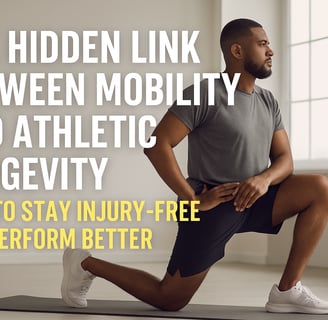The Hidden Link Between Mobility and Athletic Longevity: How to Stay Injury-Free and Perform Better
Discover how mobility training can extend your athletic career, reduce injuries, and boost performance. Learn actionable mobility strategies and top Amazon tools to help you move better, recover faster, and train smarter—no matter your sport.
5/19/20253 min read


The Hidden Link Between Mobility and Athletic Longevity
When people think of high-level athletes, they usually picture explosive power, speed, and strength. But here’s what most overlook—mobility is one of the biggest secrets behind long-term performance. It’s not flashy. It’s not always fun. But it’s the one thing that can keep your body moving better, for longer.
Whether you’re playing sports competitively or just training hard, your ability to move well is what protects you from injuries and burnout. Let’s break down why mobility matters and how to make it a key part of your training routine.
What Mobility Actually Means
Mobility isn’t just stretching or touching your toes. It’s the ability to move your joints through their full range of motion with control. It includes flexibility, yes—but also joint stability, muscle activation, and neuromuscular coordination.
You can be super strong or flexible, but if you don’t have real mobility, you’ll feel stiff, restricted, and eventually, you’ll move in ways that wear your body down over time.
Why Athletes Need to Care (Especially with Intense Training)
As training volume goes up, the body takes more hits—literally and figuratively. Without mobility work, your joints and tissues start to tighten up, and your movement patterns get sloppy.
That’s when you see:
Chronic tightness in hips, hamstrings, or shoulders
Overuse injuries like tendonitis and lower back pain
Limited range in lifts and sport-specific movements
Long recovery times and frequent soreness
The truth is, the more you push your body, the more recovery and movement quality matter.
Product Toolbox: TriggerPoint GRID Foam Roller
A foam roller is one of the best ways to improve mobility and speed up recovery. This one’s a staple for a reason.
Multi-density surface mimics a real massage therapist’s hands
Helps reduce muscle tension, improve circulation, and increase range of motion
Durable and firm—perfect for glutes, quads, back, and calves
Use it before workouts to prep tissues and after to recover faster. 60 seconds per muscle group goes a long way.
How Mobility Boosts Performance (Not Just Longevity)
The better your mobility, the smoother and more powerful your movements will be. That means:
Deeper squats, safer deadlifts, and stronger overhead work
Quicker, more efficient sprint mechanics
Less energy wasted due to stiff or restricted joints
Fewer compensations, which means less pain and fewer setbacks
Think of mobility as the groundwork for everything else you do. Without it, you’re building power and strength on a shaky foundation.
Product we recommend : Fit Simplify Resistance Loop Bands
These are super helpful for activating muscles and improving joint control.
Fit Simplify Resistance Loop Exercise Bands
Comes in multiple resistance levels, perfect for warm-ups and mobility drills
Helps activate glutes, shoulders, and stabilizer muscles pre-training
Lightweight and portable—great for home, gym, or travel
Try lateral band walks, shoulder openers, or hip bridges before your workout to fire things up and build better movement patterns.
Real Talk: Athletes Who Move Better, Last Longer
We’ve all seen it—athletes who dominate early but get sidelined by injuries, and others who stay consistent for a decade. The difference often comes down to how they treat their body outside of training.
Mobility isn’t glamorous, but it’s what lets you train hard without breaking down. If you want to compete longer, recover faster, and train smarter—not just harder—this has to be part of your daily flow.
So, How Do You Build a Solid Mobility Routine?
It’s not complicated—but it does require consistency. Here’s a simple structure:
Before training: Do 5–7 minutes of dynamic mobility (band work, joint circles, bodyweight movements).
After training: Spend 5–10 minutes foam rolling and stretching tight areas.
On off days: Dedicate 10–15 minutes to focused mobility work (hips, spine, shoulders).
Daily touchpoint: Even just 5 minutes a day keeps joints loose and blood flowing.
Make it part of your warm-up, your wind-down, or your morning routine. The point is: keep it consistent.
Product we recommend : Theragun Mini 2.0
If you're serious about recovery and mobility, a massage gun can be a game-changer.
Compact but powerful percussive therapy tool
Targets deep tissue to relieve tight spots and improve circulation
Super quiet, lightweight, and travel-ready
Use it on calves, quads, glutes, or shoulders—especially after high-volume training or long travel days.
Final Thoughts
Mobility is the hidden edge most athletes ignore—until it’s too late. But if you build it into your routine now, it’ll pay off with stronger lifts, smoother movement, fewer injuries, and a longer, more consistent career.
Whether you're lifting, running, jumping, or just living an active lifestyle, mobility is the secret weapon that keeps everything firing on all cylinders.
Invest in the little habits—stretching, rolling, activation work—and pair them with tools like bands, foam rollers, and recovery gear. Your future self (and joints) will thank you.
FITNESS
Nutrition
WellnesS
info@movebetterco.com
© 2025. All rights reserved | Privacy Policy | Terms & Conditions